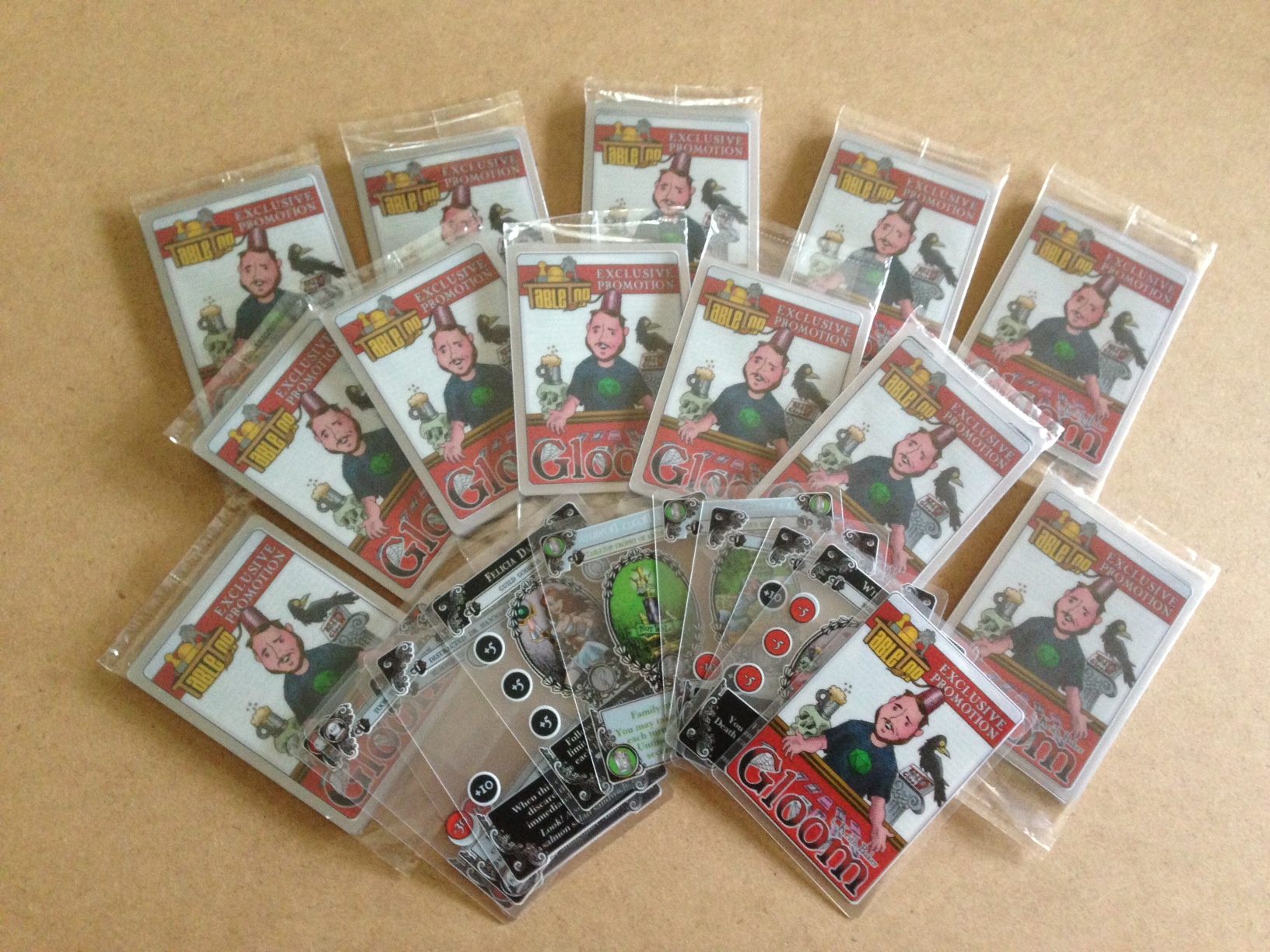At the moment, most of my attention is focused on Gloom. With TableTop Day and the special promo release approaching, I’ve been working on a variety of support; you’ll be seeing a number of Gloom videos and articles over the next few weeks. However, I recently answered these two questions and figured I’d share them with you. The Archivist question is a fairly obscure topic, but there’s some interesting story potential even if you don’t use the Archivist class. As always, these answers are my personal opinion and may contradict canon sources.
Check back tomorrow for more Gloom news!
Of all the lands across Eberron, the one that I find most mysterious is the vast underground realm of Khyber. I have read about the Underdark of Forgotten Realms and the Darklands of Pathfinder. There is not much detail about the realms. Nothing about its terrain, lifeforms, other denizens etc. Will these be addressed in upcoming future?
Khyber is a fundamentally different place than the Underdark. Here’s a quote from the Eye on Eberron article “The Inner Sun”:
Walk through the typical cave, and you’ll find what you expect to find: slick rock, stalagmites and stalactites, molds and insects. But there is more to Khyber than mundane matter. The proper passage in Khyber can take you to the Abyss, or to the furnaces of Fernia. The Vale of the Inner Sun is a similar place, a pocket of space loosely connected to the material world. The heart of the vale is only about a hundred miles in diameter, but it’s possible that the entire place is larger than Khorvaire.
Khyber isn’t just a set of caves; it is a different layer of reality. What you find going through one passage to Khyber may be completely different from what I find down a different tunnel just a dozen miles away. In the Forgotten Realms, the Underdark is a country that happens to be under the map. Khyber has a few of those—the lost kingdom of the dwarves destroyed by the Daelkyr, the realm of the Umbragen, the home of the Kech Ghaalrac—but you could still take a fork in the road and find something entirely different.
In other words, there’s not a lot of information about the terrain and lifeforms found in Khyber because there’s an almost endless array of it. You can find the realms of the Daelkyr and their aberrant hordes. You can find the Umbragen drow. You can find devious Derro in the ruins of Noldrunhold, or the Vale of the Inner Sun. The catch is that you can’t walk from the Vale of the Inner Sun TO Noldrunhold without passing back through Eberron; the two are on different planar layers.
Essentially, as opposed to being one more country, Khyber is a sandbox that can contain whatever the story calls for. The Vale of the Inner Sun in Dragon 414 is an example of one of the realms of Khyber… but you can make one that’s entirely different.
Will there be more information released about Khyber? I’d love to write a supplement containing a number of different layers of Khyber, and expanding on the Daelkyr, the Umbragen, the lost empire, and other Khyberians we’ve already discussed. However, at the moment I’m not aware of any plans for future Eberron support, so I wouldn’t get your hopes up.
I’m sorry if this question is out of left field, but it’s always been kinda difficult for me and my game groups to answer in a way that satisfies and I would welcome your opinion. How do Archivists (from Heroes of Horror) fit in? Archivists seem to treat divine magic the way that wizards and artificers treat arcane magic: they approach it like a science. Yet I’ve read in some of your previous posts that in Eberron, the fact that divine magic can’t be treated like science is what makes it distinct.
If you’re not familiar with the Archivist class, you can find it online here.
In introducing Archivists to an Eberron campaign, I think that the first question you need to ask is whether the class is in fact employing divine magic. It is the case that I see arcane magic as being driven by a scientific approach to the manipulation of magical force, while divine magic is driven by faith and, theoretically, some element of divine intervention. As such, if an archivist is truly capable of casting divine spells without faith, I would argue that it’s not a divine class; rather, it is an arcane class that is duplicating the effects of divine spells through arcane means. I’d actually consider their spells to be arcane for any purpose that distinguishes between arcane and divine, even though they are duplicating the effect of divine spells.
With that said, I think it’s quite possible to use the archivist as a divine class. Just looking at the description of the class itself…
While most archivists are religious, it is fundamentally their way to put more stock in the power of the divine than in the divine itself… Some hunt down the secrets of ages past to exalt the greater glory of their deity, while others seek only to safeguard sacred lore from falling into the wrong hands. Still others see very little connection between their personal devotion and the work they do, aside from perceiving their continued success as evidence of their god’s favor.
So per the class description, most archivists are devout; they simply approach the working of divine miracles in a scholarly way as opposed to fervent supplication.
I think there’s a very obvious path for the divine archivist. Aureon is the Sovereign of Law and Lore. He is the patron god of wizards, who teaches the value of science and its ability to shape reality. Now take this and add it to the syncretistic approach of the Sovereign Host, whose followers maintain that ALL religions are simply worshipping the Sovereigns by different names. Many faiths are quite obviously doing that, such as the giants of Xen’drik. In the past, I’ve suggested that when new cleric spells are added by new supplements, rather than making them instantly available, DMs should find a way to introduce them organically into the campaign—so in exploring the Grand Temple of Ourelon in Xen’drik, an enormous prayerbook written by giants may reveal a new way to invoke Aureon that leads to the new spell. Which brings us to the Archivist: A divine scholar who studies other cultures and delves into ruins in search of new ways to reach the Sovereigns. It could well be that a new prayer CAN’T be instantly accessed by a traditional priest; rather, the Archivist identifies it, copies it, masters it, and then finds a way to translate it into a ritual that modern priests can use. So I could see the Archivists of Aureon being a highly respected order of priests.
The same approach could apply to the Silver Flame; an Archivist of the Silver Flame could study serpent cults, fight alongside the Ghaash’kala, and venture into the ruins of Khalesh to find the ways in which other cultures have drawn on the power of the Silver Flame, and translate those rituals into a form that works for the modern church. In so doing they further understanding of the Flame and its mission; they could also be charged to catalog the Overlords of the First Age and other fiends bound by the Flame.
While such an Archivist is trained to perform their rituals in an academic manner, they are still driven by a core of faith, and it’s that belief that allows them to recognize and master the key elements of a new ritual. As I said, I think such Archivists would be treated with respect and awe by others who share their religion; they are expanding our understanding of the faith.
The reason I’d take this approach is that it plays to the idea of the Archivist as explorer. This isn’t work you can do from a library. You must find the ruins of other cultures that shared your faith, or interact with other cultures that practice your religion through a different lens. If you stay at home, you can only touch the gods in the ways you already know; the Archivist ventures out into the world to learn new ways to reach the divine. It’s not “scientific” in a way that defies faith; it’s a quest to broaden the concept of what can be accomplished with faith. It ties to the idea that the core religions have been practiced by many different cultures, and that each one may have different techniques. I think it’s a great idea for an adventurer. But to me, the Archivist is still driven by his faith, and the idea that we can always learn more about the divine.
If you’re fixed on the idea of the Archivist as a faithless individual who approaches magic from a purely abstract and scientific place, as I said I’d make that character and his magic arcane instead of divine. I’d also make it an entirely new thing, not an established order; it represents a new, entirely modern approach to magical theory that isn’t reflected by society as it stands. Both the Arcane Congress and the Twelve would be likely sponsors, depending on whether the character is affiliated with the dragonmarked houses or the Five Nations. Both the Arcane Congress and the Twelve have considerable resources and are striving to expand the potential of arcane science. Of course, the Twelve will ultimately put these discoveries to industrial use, while the Arcane Congress will use them to support Aundair and the rest of the Five Nations… but finding a way for arcanists to reproduce divine effects would certainly strengthen Aundair and weaken Thrane.
If you go with the Twelve, House Sivis is actually the house that immediately comes to my mind. Phiarlan is certainly about chronicling history, but Sivis is the one that is looking at the power of the word, and which would be most inclined to look to a prayer as a linguistic tool that channels magical energy.
What kinds of interactions would an archivist provoke from clerics and druids?
A divine Archivist such as I’ve described above would be respected by clerics, because they are seeking to expand understanding of the faith, not to undermine it. An arcane Archivist—a faithless individual seeking to pillage the blessings of the divine for secular use—would likely receive a very negative reaction from people of faith. Divine magic is a blessing; for you to try and harness it purely for personal gain is deeply offensive.
As for druids, it will definitely depend on the sect. I wouldn’t expect any druidic sect to be thrilled by a faithless scholar trying to learn their secrets… and the Ashbound in particular would likely have a very violent response to the idea.
Would any other houses employ them as an alternative to other divine casters? How might this affect Jorasco and their business?
Personally, I don’t see Archivists as being an alternative to divine casters. First off, ALL PC classes are rare. You don’t generally hire a cleric; you hire an adept or magewright. And I’d consider an Archivist to be far rarer than a cleric. Again, as I see it, at the core of the thing an Archivist is an explorer; an Archivist who just goes to work at a Jorasco house of healing is abandoning his quest for knowledge. How is a person who gives up so easily for a little gold going to have the drive to become an Archivist in the first place? I think it’s more likely that the arcane Archivist would work for the Twelve, seeking to break down the barrier between the arcane and the divine so that magewrights can learn healing magic and work for the houses.
As far as how it would impact Jorasco’s business, bear in mind that most of Jorasco’s business actually involves mundane treatment. Adventurers aside, people don’t generally go to a Jorasco house for Cure Light Wounds or even Cure Disease (which is available but expensive); they go to be treated by experts in the Heal skill. The spells and rituals are available through dragonshard focuses or house adepts, when needed. If some archivist sought to set up a new secular healing service, it would be as though someone started selling airships than don’t require the Mark of Storms, and would likely be treated the same way. The houses have the power they have because they are monopolies. If this new business truly looks like it could pose a threat—as opposed to being one single healing house in a continent filled with Jorasco houses—they could attack it in any number of ways, from spreading slander and scandalous rumors to employing Thuranni assassins to take out the Archivist.
Given the strict control of arcane magic in Riedra, would archivists be viewed in the same light?
Unless they are acting in the service of the Inspired, absolutely.
In a recent thread on the WoTC site you said that the Silver Flame is not a god, and in these posts you mentioned that while not being an impersonal force it is not an anthropocentric deity. I think (but may be wrong) that Faiths of Eberron said that the SF is a god. I was wondering if this is one of those aspects, as the mourning, left for the DM to decide, and that thus the SF can or cannot be a god created by the sacrifice of the Couatls depending on each DM. Otherwise, if it is not a god, could it be a force that is ultimately serving a good deity, perhaps a major one that is not even from the Sovereign Host but a benign more powerful being?
EVERYTHING in Eberron is left for the DM to decide. “Canon” is simply inspiration. With the Mourning, we don’t even GIVE you an answer… but you can always change anything you’d like. What you have hear is an example of that. Faiths of Eberron is technically a canon source. However, I disagree with a number of key elements of its depiction of the Silver Flame, and run things differently at my table. It’s always up to you to do what you want to do. So moving on, let me explain why I do what I do.
The Silver Flame is fundamentally different from the deities of the Sovereign Host. The followers of the Host assert that their deities are omnipresent and shape all things. Any time a smith picks up a hammer, Onatar is with him. Any time a soldier draws a sword, the Three Faces of War are watching. How do you KNOW Onatar is with the smith? Because he produced good work. So essentially, the Sovereigns are omnipresent, but there is no concrete PROOF of their existence; it’s a matter of faith.
The existence of the Silver Flame isn’t a matter of faith. We know with absolutely certainty that it exists, because if it didn’t the Overlords would be rampaging across the world. The SIlver Flame is an energy field that holds fiends at bay. It was created by the sacrifice of the Couatl, and according to the articles of the faith, strengthened ever since then by noble mortal souls. Mortal champions of the faith can draw on the power of the Flame to perform divine magic. Essentially, this is like a Jedi Knight and the Force. There’s no question as to whether the Force exists; it’s just a matter of whether you are personally capable of touching it and harnessing its power. And similarly, the Force isn’t something that acts on its own; it empowers the Jedi Knights to serve as champions, but it can’t stop the Jedi from being hunted down or from falling to the dark side. It can guide and it can strengthen… but it can’t MAKE anything happen on its own.
Beyond this is the question of what it even “wants”. Because it’s not an anthropomorphic entity. It’s not one being; it’s the souls of hundreds of thousands of beings merged together. They are united by basic beliefs – defend the innocent from harm – but they aren’t ONE MIND. This is the idea of the Voices of the Silver Flame. You can’t have a conversation with the Silver Flame, because the Silver Flame isn’t an individual entity. So a Voice of the Flame is a soul that doesn’t merge with the Flame as fully as most; instead it retains enough identity that it CAN directly interact and guide the faithful on some level. Tira is the Voice to the modern church; in my opinion, every branch of the faithful – from the Ghaash’kala to the Khaleshites – have their own voices. But Tira ISN’T the Silver Flame; she’s like an ambassador. She’s not infallible. She’s not even divine. She’s a mortal soul who gave up her life to defend the innocent from evil. Essentially, she’s a saint. It’s Tira who whispers in your conscience, and Tira who answers commune. But she’s not a god. She can’t affect reality on her own. She can only offer guidance.
Which comes to your next question: “could it be a force that is ultimately serving a good deity?” The Silver Flame can’t serve anything, because that implies that it is capable of independent action. The Silver Flame is a resource. It’s a wall that stands between us and cosmic horror, and a well that virtuous people can learn to draw from. But again, it’s like the Jedi: the Force is the tool that the Knight uses to do good, but if there are no Knights, it can’t act on its own.
Tied to this is the point that Tira Miron was herself a paladin of Dol Arrah. In dedicating herself to the Silver Flame, she wasn’t breaking some sort of vow to Dol Arrah. The existence of the Silver Flame doesn’t in any way contradict or oppose the existence of Dol Arrah; it’s simply operating on a different level. Trust me, the priests of Dol Arrah do say that the Silver Flame is simply a manifestation of Dol Arrah’s divine light; the priests of the Silver Flame simply take the view that the Flame is a concrete force while Dol Arrah is an abstract one. Generally, followers of Dol Arrah and the Silver Flame work well together; the followers of the Flame are simply more pragmatic, if you will.
This ties to my second disagreement with Faiths of Eberron: The idea that the struggle against evil can be “won.” I’ve discussed this before, but to sum up: as I see it, the Silver Flame is a concrete, real force that protects us from darkness and grants its champions the strength to carry on that fight in the present day. There will always be evil; even if you completely eliminated it, all it takes is one new person thinking an evil thought to bring it back into the world. Unlike the Blood of Vol – whose followers think Death can be destroyed – the followers of the Flame don’t fight because they believe the battle can be WON; they fight because it is by fighting that they make the world a better place. Perhaps we can reach a world where no one need fear evil, where no one is endangered by it – but we will always need those who remain vigilant for new dangers, and who are prepared to fight them. Looking again to the Jedi, the Empire can be defeated… but that doesn’t mean that there will NEVER BE EVIL AGAIN, it just means that for the moment the universe is a better place.








